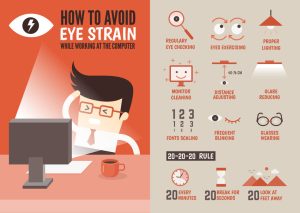In the digital era, where screens are an integral part of daily life, digital eye strain, or computer vision syndrome, has emerged as a common concern. This condition manifests through various symptoms, including eyestrain, headaches, blurred vision, dry eyes, and neck pain, predominantly due to extended screen usage.
By synthesizing findings from multiple studies, we can develop a comprehensive strategy to address and alleviate digital eye strain effectively.

Awareness and prevalence: In 2022, a study led by Chizoba Udoka Uba-Obiano, a faculty member in the Department of Ophthalmology at Nnamdi Azikiwe University, Awka, brought to light the significant awareness of digital eye strain among bank workers in Onitsha, Nigeria.
This study, which reported a prevalence rate of 29.3%, underscored the critical need for implementing protective measures to mitigate the negative effects of prolonged computer usage.
Ergonomic factors: Abdu Gambo, a lecturer at the Faculty of Technology Management, Universiti Tun Hussein Onn Malaysia, conducted a pivotal study in 2017. Focusing on office ergonomics within Nigerian state-owned tertiary institutions, Gambo’s research revealed that suboptimal ergonomic conditions, notably the mismatch of chair and desk heights, play a substantial role in increasing the risk of digital eye strain.
Visual symptoms and prevention: In their 2020 research, Akinbinu T. R. and Mashalla Y. J. observed a variable prevalence of visual symptoms linked to extended screen time. Their findings highlight the necessity for a deeper understanding and the implementation of effective preventive measures against computer vision syndrome.
Risk factors and management: A 2018 study shed light on the various risk factors associated with digital eye strain, including individual visual problems and inadequate ergonomic setups. The study emphasized the importance of precise diagnosis and treatment of the syndrome, stressing the significance of adopting preventive strategies to safeguard eye health.

Strategies derived from research
Follow the 20-20-20 rule: This rule is beneficial for resting the eyes and reducing fatigue.
Optimize your workspace: Ergonomic adjustments to your workspace, as suggested by various studies, can significantly reduce eye strain.
Adjust screen settings: Based on findings, adjusting the brightness, contrast, and text size can help in minimizing eye discomfort.
Blink more often: To counteract the dryness caused by reduced blink rates, it is essential to blink more frequently.
Use proper lighting: Controlling lighting to reduce glare on screens is a critical factor in preventing eye strain.
Take regular breaks: Incorporating longer breaks into your routine, as highlighted in research, can be effective in mitigating eye strain.
Consider computer glasses: These glasses can optimize eyesight when looking at digital screens, as pointed out in the studies.
Conclusion
Addressing digital eye strain requires a comprehensive approach informed by various research findings. B
y adopting strategies such as the 20-20-20 rule, ergonomic workspace optimization, and the use of computer glasses, individuals can significantly reduce the discomfort associated with prolonged screen use.
It’s important to continually apply these research-backed strategies for maintaining healthy vision in our digitally-driven lifestyle.


